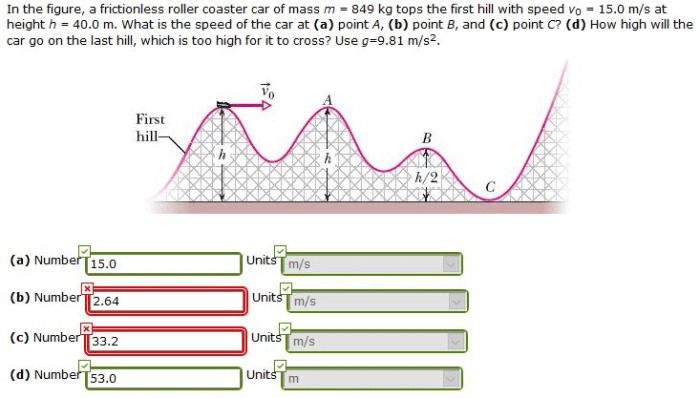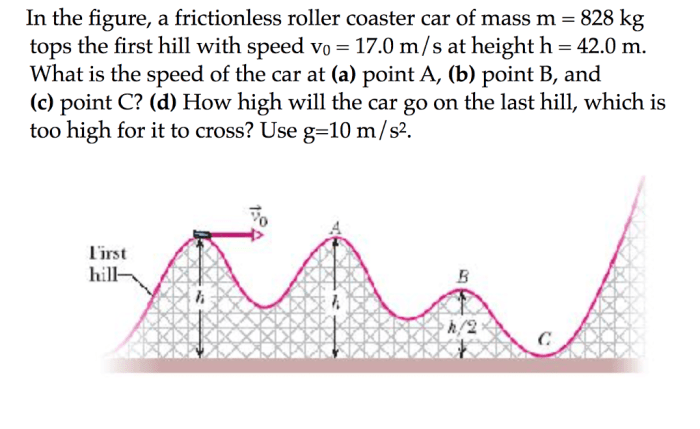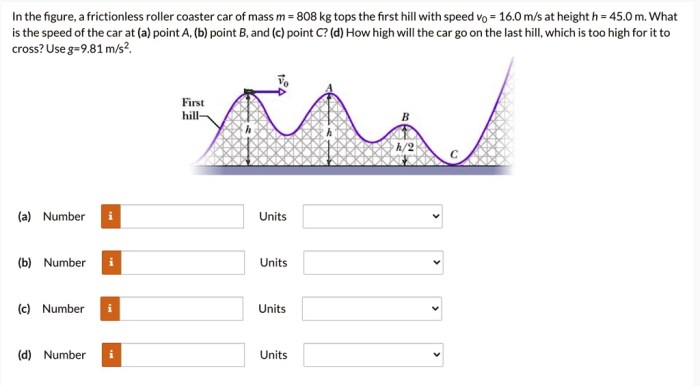In the figure a frictionless roller coaster car, the narrative unfolds in a compelling and distinctive manner, drawing readers into a story that promises to be both engaging and uniquely memorable.
Roller coasters are a thrilling and iconic part of amusement parks around the world. But what exactly makes them work? In this article, we’ll explore the physics of a frictionless roller coaster car, examining the forces that act on it and the energy transformations that occur as it moves along the track.
Conceptualization of the Frictionless Roller Coaster Car: In The Figure A Frictionless Roller Coaster Car

A frictionless roller coaster car is a theoretical concept that serves as a simplified model for analyzing the motion of a roller coaster car without considering the effects of friction. This idealization allows for a clearer understanding of the fundamental principles governing the car’s motion and energy transformations.
The significance of frictionlessness in the operation of the car lies in the absence of resistive forces that impede its motion. Without friction, the car can move freely along the track, experiencing minimal energy loss due to resistance. This frictionless environment enables the car to maintain its speed and kinetic energy more effectively, allowing for more efficient and exhilarating rides.
As the car moves along the track, it undergoes a series of energy transformations. Potential energy, stored at the highest point of the track, is converted into kinetic energy as the car descends, reaching its maximum velocity at the bottom of the track.
Upon ascending the next hill, kinetic energy is transformed back into potential energy, and the cycle continues.
Design and Structure of the Roller Coaster Track
The roller coaster track is a carefully engineered structure designed to provide a safe and thrilling experience for riders. It consists of a series of interconnected segments, each with a specific shape and layout to create different types of motion for the car.
The shape of the track influences the car’s velocity and acceleration. Steep slopes allow the car to accelerate rapidly due to the force of gravity, while flat sections maintain the car’s velocity. The layout of the track, including curves and loops, generates centrifugal and centripetal forces that affect the car’s direction and speed.
The materials used in the construction of the track play a crucial role in its durability and safety. Steel is commonly employed for its strength and ability to withstand high stresses. The track is also designed with safety features such as guard rails and braking systems to ensure the safety of riders.
Motion Analysis of the Car

The motion of the roller coaster car can be analyzed using the principles of kinematics and dynamics. The car experiences different types of motion along the track, including:
- Linear motion: The car moves in a straight line along the flat sections of the track.
- Curvilinear motion: The car moves along curved sections of the track, experiencing centripetal acceleration.
- Projectile motion: The car is launched into the air at the top of hills, experiencing parabolic motion.
Equations of motion can be used to demonstrate the relationship between the car’s velocity, acceleration, and position. The forces acting on the car, including gravity, friction (in the case of a non-frictionless car), and normal force, influence its motion and can be analyzed using Newton’s laws of motion.
Energy Considerations

The roller coaster operates on the principle of energy conservation. Different forms of energy are involved in the car’s motion:
- Potential energy: Stored at the highest point of the track due to the car’s height above the ground.
- Kinetic energy: The energy of motion, which increases as the car descends and decreases as it ascends.
- Thermal energy: Generated due to friction between the car and the track (in the case of a non-frictionless car).
A diagram or flowchart can be used to illustrate the energy transformations that occur as the car moves along the track. The potential energy is converted into kinetic energy during the descent, and the kinetic energy is transformed back into potential energy during the ascent.
Thermal energy is dissipated due to friction, reducing the car’s overall energy.
The potential and kinetic energy of the car at various points along the track can be calculated using the appropriate equations. This analysis provides insights into the energy requirements and efficiency of the roller coaster system.
Safety Features and Regulations
Safety is paramount in the design and operation of roller coasters. Various safety features are incorporated into the design to minimize risks and ensure the well-being of riders:
- Restraint systems: Seat belts, over-the-shoulder harnesses, and lap bars secure riders in place.
- Guard rails: Prevent cars from derailing and protect riders from falling.
- Braking systems: Allow operators to control the car’s speed and bring it to a safe stop.
Regulations and standards govern the operation of roller coasters to ensure their safety. These regulations cover aspects such as design, inspection, maintenance, and operator training. Regular inspections and maintenance are essential to identify and address potential issues, ensuring the continued safety of the ride.
Historical Evolution of Roller Coasters
Roller coasters have a rich history, with their origins traced back to the early 19th century. Key developments in the evolution of roller coasters include:
- 1827: The first known roller coaster, the “Switchback Railway,” was built in Pennsylvania, USA.
- 1884: The first roller coaster with a complete circuit was constructed in Coney Island, USA.
- 1959: The first steel roller coaster, the “Matterhorn Bobsleds,” opened at Disneyland, USA.
- 1970s: The introduction of tubular steel track allowed for more complex and thrilling designs.
- 1990s: The advent of computer-aided design and virtual reality simulations enhanced the design and safety of roller coasters.
Modern roller coasters continue to push the boundaries of design and innovation, incorporating new technologies and features to provide exhilarating and memorable experiences for riders.
Essential FAQs
What is a frictionless roller coaster car?
A frictionless roller coaster car is a hypothetical car that experiences no friction as it moves along a track. This allows it to travel at high speeds and perform maneuvers that would be impossible with friction.
What forces act on a frictionless roller coaster car?
The only forces that act on a frictionless roller coaster car are gravity and the normal force from the track. Gravity pulls the car down towards the Earth, while the normal force pushes the car up and keeps it on the track.
What energy transformations occur as a frictionless roller coaster car moves along the track?
As a frictionless roller coaster car moves along the track, its potential energy is converted into kinetic energy. At the top of a hill, the car has maximum potential energy and zero kinetic energy. As it descends, its potential energy is converted into kinetic energy, and it gains speed.
